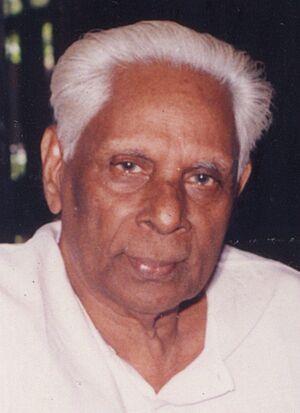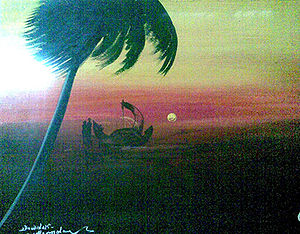Thirunalloor Karunakaran facts for kids
Quick facts for kids
Thirunalloor Karunakaran
|
|
|---|---|

Thirunalloor Karunakaran
|
|
| Born | 8 October 1924 Kollam, Kerala, India |
| Died | 5 July 2006 (aged 81) Kollam, Kerala, India |
| Occupation | Poet |
| Nationality | Indian |
Thirunalloor Karunakaran (born October 8, 1924 – died July 5, 2006) was a famous poet, smart thinker, and teacher from Kerala, India. He was also known for his support of leftist ideas.
Contents
His Life Story
Growing Up
Thirunalloor Karunakaran was born in a village called Perinad. This village is in the Kollam district of Kerala. His parents were P. K. Padmanabhan and N. Lakshmy.
He started learning Sanskrit, an ancient Indian language, in the traditional way even before he went to primary school. From a young age, he was interested in movements that supported working people. While still in school, he published his first book. It was a Malayalam translation of a poem by Oliver Goldsmith. He wrote many poems, song lyrics, and articles for magazines during his student days. He became well-known during a time called the Pink Decade in Malayalam poetry.
By the time he went to college, he had met important Communist leaders like R. Sugathan and M. N. Govindan Nair. These connections made him a strong supporter of the Communist Party of India.
His Work and Achievements
After getting his first degree in history from S. N. College in Kollam, he worked there as a tutor for a short time. Soon after, he joined University college in Trivandrum to study Malayalam further. There, he learned a lot about Kerala's history from Elamkulam Kunjan Pillai. This historian greatly influenced Thirunalloor's thinking.
After earning his Master's degree in Malayalam, he became a college lecturer for the government. He taught at Government Arts College and University College. He also served as a member of the Kerala Public Service Commission for six years. Later, he worked as the editor of Janayugam. This was a weekly magazine about culture published by the Communist Party of India. In 1973, he visited the Soviet Union. He was part of a group of Indian writers who went to the Afro-Asian Writers Conference in Kazakhstan.
Thirunalloor Karunakaran received many awards for his work. These include:
- Asan Award (1984)
- Vayalar Award (1988)
- Muloor Award (1992)
- Abudabi Shakthi Award
- Kerala Sahitya Academy Award for his lifetime contributions (2000)
Later Life and Legacy
Even though he lived in Trivandrum for over 30 years, Thirunalloor decided to spend his last years in his home village of Perinad. This village is located by the beautiful Ashtamudi lake. The lake was a constant source of ideas and inspiration for his poems.
He passed away on July 5, 2006, at his home in Quilon. He had wished to be buried without any religious ceremonies, and his wish was followed. In his final years, he was writing a long poem called 'Seetha' (Sita). This poem offered a new way of looking at the famous Ramayana story.
Every year, a three-day cultural festival is held to remember him. It is called 'Thirunalloor Kavyolsavam'. This festival takes place from May 1st (International Workers' Day) on the banks of the Ashtamudi lake in Quilon.
His Ideas and Poems
Thirunalloor deeply studied both Marxism and Indian philosophy. He worked to bring together the best parts of both these ways of thinking. This idea is very important in all his poems. In many of his poems, he shows how people working together, both physically and mentally, helps them grow and become free. Poems like Tharisu nilangalilekku (To the barren fields), Parayudappukar (The Granite crushers), Adyathe Theevandi (The First Train), and Kayamkulam Kayal (Kayamkulam Lake) all show this idea.
The Ashtamudi lake and the lives of people living near its shores were a big source of inspiration for his writings. His poetry is full of different themes, characters, and pictures taken from this environment. He also wrote short poems about simple, passing feelings. Besides these, he wrote long story-poems with many different characters and complex social situations.
Many of his works have not yet been put together into collections. These include song lyrics he wrote for various media and art forms like Kadhaprasangam (storytelling performances) and stage plays. He also wrote marching songs, articles, and works in Sanskrit. This includes his Sanskrit translation of Kumaran Asan's Chandala Bhikshuki and his studies on Indian aesthetics (the study of beauty and art).
Thirunalloor did not believe in God. He thought that Indian philosophy was mostly about the real world, not about religion. He strongly believed that people should look closely at the Bhagavad Gita and the ideas of Shankaracharya (Adi Shankara). He wanted to show their less positive sides. He said that Shankaracharya supported the caste system and that the Bhagavad Gita seemed to allow violence.
See also
 In Spanish: Thirunalloor Karunakaran para niños
In Spanish: Thirunalloor Karunakaran para niños
- Rani (poem)
- Marxist aesthetics
- Malayali


